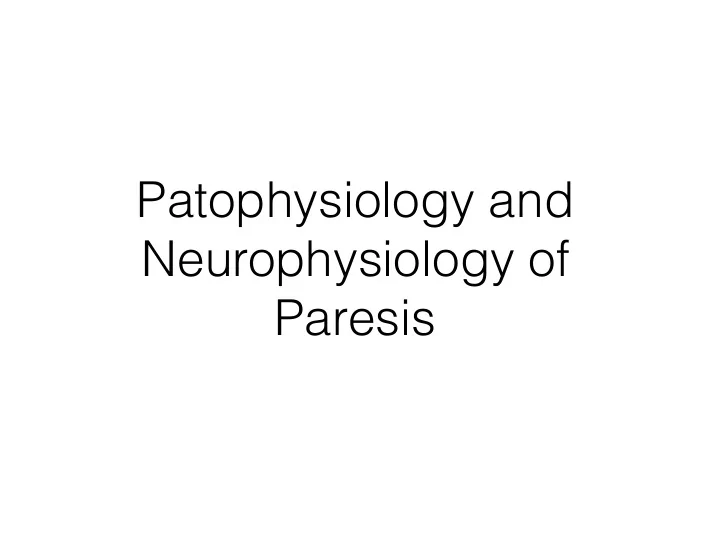

Patophysiology and Neurophysiology of Paresis
Definition of Paralysis (Gracies, Muscle and Nerve, 2005) Paralysis is defined as decreased voluntary motor unit recruitment , that is the inability or difficulty to voluntarily recruit skeletal motor units to generate torque or movement
Paresis (Gracies, Muscle and Nerve, 2005)
Classification of the cortical spinal tract from the view point of brain rehabilitation (Sung Ho Jang, MD,2014) • The are 3 separate Cortical Spinal Tracts: crossed lateral CST, uncrossed lateral CST, uncrossed anterior CST. The CSTs were found to originate from M1 (36,9%), S1 (31,7%), SMA (24,7%) and the dorsal PMC (6,7%). CST fibers from the M1 and S1 have similar characteristics, unlike CST fibers from dorsal PMC or SMA. This characteristic of S1 appears to be associated with the high incidence of reorganization into S1 following an M1 infarct. • Patients can show different neurological manifestation, such as motor weakness, limb kinetic apraxia or somatosensory-motor incoordination according to the cerebral origins of the injured fibers. CST fibers from a different cerebral origin can compensate for the function of the injured CST fibers. • Existence of collaterals of the CST (Aberrant Pyramidal Tract-APT), that could function as a motor recovery mechanism in patient with a cerebral infarct.
Classification of the cortical spinal tract from the view point of brain rehabilitation (Sung Ho Jang, MD,2014) Anterior CST (5-15% of Crossed lateral CST (75/90% of the CST) : the CST) : • It extends caudally only • Distal muscles for the fingers to the upper thoracic and the ankles • Greater involvement in motor cord and doesn't cross medulla function of the upper • It innervates the proximal extremities than in lower muscles of the neck, extremities • Fingers extensor most trunk and proximal upper extremities accurately reflect the function • It has a role in walking of this tract • Lateral CST is mandatory for hand function, association of Uncrossed lateral CST walking is not as strong as that (5-15% of the CST) : of hand function • Its function is unknown and the sizes varies among individuals
Classification of the cortical spinal tract from the view point of brain rehabilitation (Sung Ho Jang, MD,2014) • In neurological rehabilitation, classification of the CSTs is important for understanding the neurological manifestations of patients and prediction of their recovery courses and prognosis
Motor sub cortex-probability of good recovery: 51% Corona radiata-probability of good recovery: 20% Internal capsula -probability of good recovery: 21%
Pathophysiology of Paresis (Gracies, Muscle and Nerve, 2005) • Failure of central voluntary activation: abnormal pattern of motor unit recruitment are explained in part by failure of central voluntary activation • Ex: difference in maximal voluntary activation between the paretic biceps brachii and non paretic (66% Vs 89%) • Loss of normal functioning motor units in the spinal cord with a reduction in the mean and maximal discharge rate of voluntary driven motor units in the paretic muscles. • Failure to recruit high-threshold motor units and to modulate or increase motor unit discharge rate during attempts to increase voluntary force.
• Loss of the trophic effect from UMNs may alter the functional state of anterior horn cells on the affected side without cell loss. Motor unit number may remain unchanged morphometrically, whereas the functional motor unit number on the hemiparetic side may decrease in stroke patients • Motor unit loss on the hemiparetic side occurred the second week after onset of upper motor neuron lesion • Motor unit loss due to trans-synaptic degeneration would take place in the acute phase and continue in the chronic state.
Pathophysiology of Paresis (Gracies, Muscle and Nerve, 2005) Changes in Motor Neural Properties in the Spinal Cord: • • Increase in threshold voltages and currents for action potential activation • Loss of normal functioning motor units and firing rate reductions may reduce the efficiency of muscle contraction with an increase sense of fatigue and effort • Fatigability (central fatigue) • Decrease in voluntary activation of lower motor neurons • Difficulty in isolating contraction to a muscle group • Only less severely paretic subjects can induce peripherical fatigue before the central one occurs
Pathophysiology of Paresis (Gracies, Muscle and Nerve, 2005) • Compensatory Process in Higher Centers . • diffuse brain task-related activations in regions normally non involved in the task, probably reflecting a recruitment of additional neural resources to compensate the lesion and more attentional and intentional mechanism • Additional activation in motor areas controlateral to the lesion • Increase in excitability in unmasking of ipsilateral corticospinal projections • Involvement of brainstem descending pathways (cortico-rubrospinal, cortico-reticolospinal, cortico-vestibularspinal systems) • Collateral sprouting of intact corticospinal fibers
Reorganization in controlesional cortex (DANCAUSE, N., 2006)
Reorganization in ipsilateral cortex (DANCAUSE, N., 2006)
Effects of paresis - implication in treatment
Recommend
More recommend